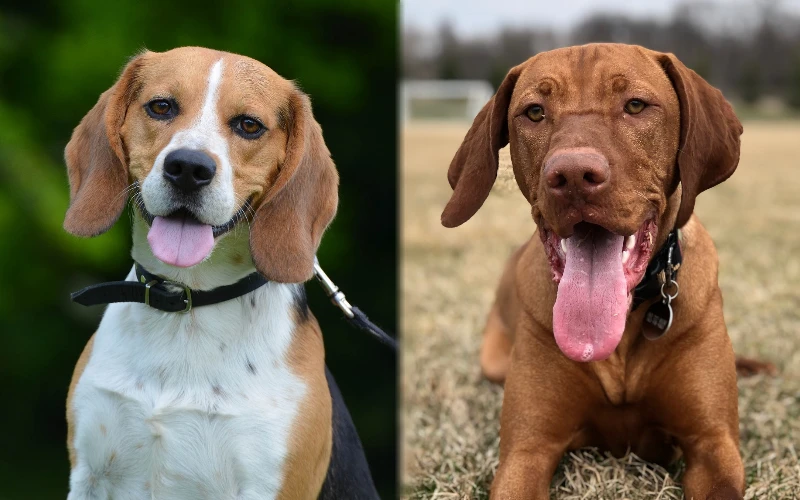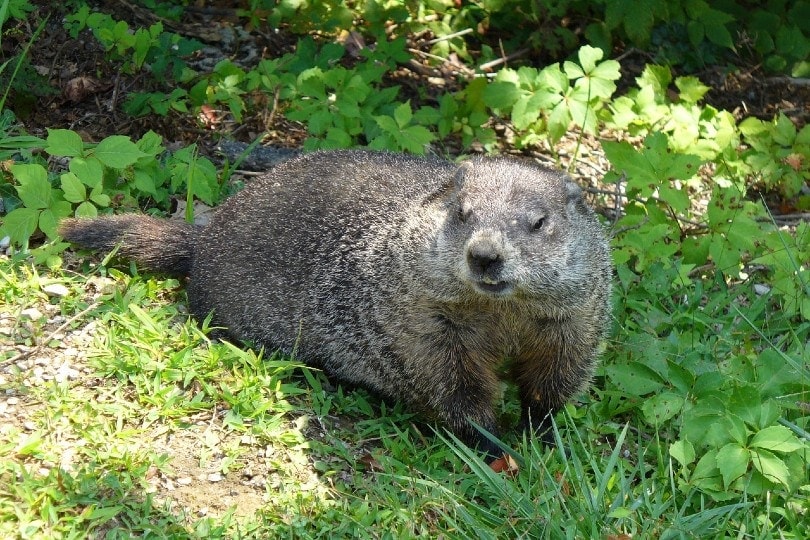Beagle Vizsla Mix: Pictures, Care Guide, Temperament & Traits
By Ed Malaker
Updated on

A Beagle Vizsla mix, also known as a Vizsla Beagle, is a crossbreed between a purebred Beagle and a purebred Vizsla, both breeds known for their intelligence, loyalty, and friendly nature. If you are thinking about getting one of these dogs but want to know more about them first, keep reading as we discuss their exercise and grooming needs and overall health, so you can make an informed purchase.
| Height: | 13–24 inches |
| Weight: | 18–65 pounds |
| Lifespan: | 10–15 years |
| Colors: | Gold-oxide or rust-red |
| Suitable for: | Active individuals and families with children, experienced dog owners |
| Temperament: | Friendly, loyal, and affectionate |
As with any mixed breed, the characteristics of a Beagle Vizsla mix can vary depending on which traits they inherit from their parent breeds. Generally, these tend to be medium-sized dogs with a muscular build, a short coat that may be smooth or wiry, and floppy ears. They are usually friendly and energetic, requiring plenty of exercise and mental stimulation. They enjoy being part of a family and are good with children but have a strong prey drive, so they tend to chase after small yard animals like rabbits and squirrels.
Beagle Vizsla Breed Characteristics
Beagle Vizsla Breed Puppies
Beagle Vizsla puppies can vary in appearance and temperament, depending on which traits they inherit from each parent breed, but they are always extremely playful and curious. When looking for Beagle Vizsla puppies, choose a reputable breeder who has screened both parent dogs for any health issues and can provide information about their temperament and history so your new pet has a better chance of being healthy. You might also want to consider adopting one from a local rescue organization, as it will run tests to check for health and temperament issues and provide other benefits that you might not receive from a breeder, like spaying/neutering and vaccination shots.

Temperament & Intelligence of the Beagle Vizsla 🧠
The temperament and Intelligence of the Beagle Vizsla can vary depending on what parent they take after, but many owners describe them as being friendly, affectionate, and good with children and other pets. They like to run around in a large yard and will enjoy a daily walk or a trip to the park to play games. They are smart dogs that respond well to positive reinforcement but can sometimes be stubborn or independent.
Are These Dogs Good for Families? 👪
Yes, Beagle Vizslas can make excellent family dogs. They are usually quite loving, so they can be a good choice for a large family. They also need plenty of exercise and mental stimulation, which a large family can provide.
Does This Breed Get Along With Other Pets?
The Beagle Vizsla usually gets along well with other dogs, but they have a strong prey drive, so you’ll need to socialize your puppy with other pets and people as often as possible while they’re still a puppy, to ensure that they will get along later in life. However, even with training, this dog will still likely chase after small animals in the yard, like rabbits and squirrels.
Things to Know When Owning a Beagle Vizsla
Food & Diet Requirements 🦴
When choosing a commercial dog food for your Beagle Vizsla, look for a product that uses high-quality whole-food ingredients, like chicken, beef, and turkey, and does not contain fillers or artificial preservatives. You may want to consider a dog food formulated for active breeds. Be sure to closely follow the portion recommendations printed on the bag to prevent your pet from becoming overweight.
Exercise 🐕
Beagle Vizslas are high-energy dogs that require plenty of exercise and mental stimulation to prevent boredom and destructive behavior. They are a mix of two active hunting breeds, so they naturally want to run, explore, and hunt. Your dog will need at least 60 minutes of exercise per day, with more being better. Activities can include walks, runs, hikes, and games of fetch in a securely fenced area. Interactive toys and puzzle games can also help provide important mental stimulation.
Training 🎾
Training a Beagle Vizsla requires patience, consistency, and positive reinforcement. They are smart dogs but can be stubborn at times. They also have a strong prey drive that can prevent them from staying focused and doing what you ask. Positive reinforcement training is the most effective way to train a Beagle Vizsla. Use treats, praise, and playtime to reward good behavior and encourage your dog to repeat it. Keep your training sessions short and consistent to help get your dog into a routine, and hold the sessions after playtime so your pet is more likely to stay focused.
Grooming ✂️
Beagle Vizslas have a short and dense coat that is relatively easy to maintain. Weekly brushing and an occasional bath are all that you will need to worry about. The ears are prone to ear infections, though, so it’s important to regularly check and clean their ears to prevent any buildup of dirt, wax, or moisture. You will also need to trim their nails if you hear them clicking on the floor and manually brush the teeth as often as possible to help slow the onset of dental disease.
Health and Conditions ❤️
- Ear Infections
Your Beagle Vizsla has long, floppy ears, making them susceptible to ear infections. Clinical signs include shaking the head, scratching the ears, and a bad odor, and treatment includes medication. You can help reduce the risk of infection by keeping the ears clean. - Allergies
Both parents of the Beagle Vizsla suffer from allergies, so your dog likely will too. These can cause itchy and runny eyes, itchy skin, and hives. Medication can help relieve side effects and make your pet more comfortable.
-
Hip Dysplasia
Hip dysplasia is a genetic condition that affects the hip joint and can cause pain and lameness, and it frequently occurs in active dogs like the Beagle Vizsla. Clinical signs include decreased activity, a swaying bunny hop gait, pain, and stiffness. Treatment includes weight loss, physical therapy, and medication. -
Progressive Retinal Atrophy
Progressive retinal atrophy is a group of degenerative diseases that affect the photoreceptor cells in the dog’s eye. Clinical signs include night blindness and fear of going into dark rooms. Unfortunately, there is currently no treatment. -
Hypothyroidism
Hypothyroidism is a hormonal disorder that can lead to weight gain, lethargy, and other health issues. It’s not curable, but doctors can treat it with thyroid replacement hormone.
 Male vs. Female
Male vs. Female
The parent that your Beagle Vizsla takes after more will have a bigger impact on your pet’s appearance and temperament than their sex, and there is no notable difference between males and females of this breed.
3 Little-Known Facts About the Beagle Vizsla
1. They Are a New Breed
Beagle Vizslas were first developed in the 1990s, making them a relatively new breed. Breeders created them to combine the Beagle’s hunting and tracking abilities with the Vizsla’s loyalty and affection.
2. They Are a Versatile Breed
Beagle Vizslas are adaptable and excel in various activities, including hunting, agility, obedience, and therapy work.
3. They Have a Unique Appearance
Beagle Vizslas can vary in appearance but generally have a muscular build, short coat, and floppy ears, and they have a range of coat colors, including brown, red, and white.
Final Thoughts
Beagle Vizslas can make great pets for an active single or large family. They are playful and affectionate and get along with children, who can help the dog get their required daily exercise. They can also get along with family pets if you socialize them early, but they do have a strong prey drive that can cause them to chase after smaller animals, like rabbits and squirrels. This prey drive can also prevent them from staying focused during training sessions, making learning new tricks a little harder.
Related Read:
- Vizsla Whippet Mix: Pictures, Temperament & Traits
- Vizsla Pitbull Mix: Pictures, Care Guide, Temperament & Traits
Featured Image Credit: Left – Beagle (825545, Pixabay) | Right – Vizsla (Daniel Johnson, Pexels)



 Male vs. Female
Male vs. Female








